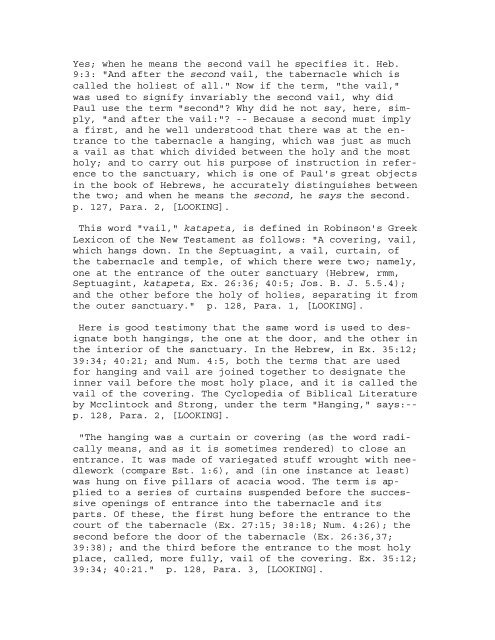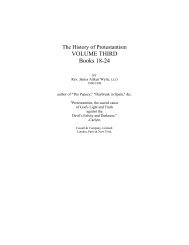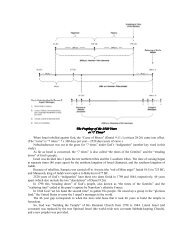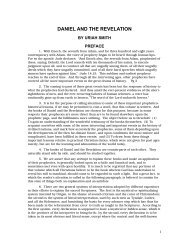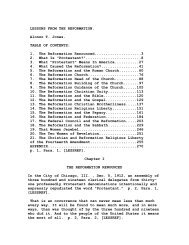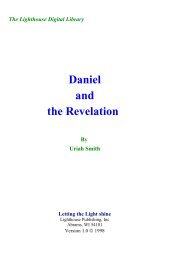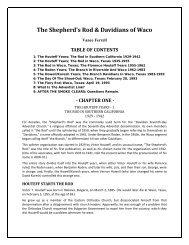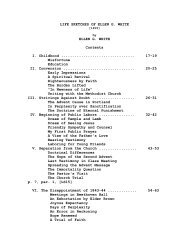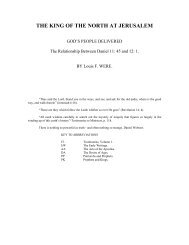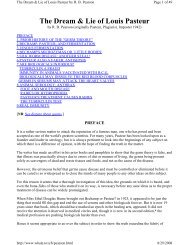LOOKING UNTO JESUS OR CHRIST IN TYPE AND ANTITYPE. BY ...
LOOKING UNTO JESUS OR CHRIST IN TYPE AND ANTITYPE. BY ...
LOOKING UNTO JESUS OR CHRIST IN TYPE AND ANTITYPE. BY ...
You also want an ePaper? Increase the reach of your titles
YUMPU automatically turns print PDFs into web optimized ePapers that Google loves.
Yes; when he means the second vail he specifies it. Heb.<br />
9:3: "And after the second vail, the tabernacle which is<br />
called the holiest of all." Now if the term, "the vail,"<br />
was used to signify invariably the second vail, why did<br />
Paul use the term "second"? Why did he not say, here, simply,<br />
"and after the vail:"? -- Because a second must imply<br />
a first, and he well understood that there was at the entrance<br />
to the tabernacle a hanging, which was just as much<br />
a vail as that which divided between the holy and the most<br />
holy; and to carry out his purpose of instruction in reference<br />
to the sanctuary, which is one of Paul's great objects<br />
in the book of Hebrews, he accurately distinguishes between<br />
the two; and when he means the second, he says the second.<br />
p. 127, Para. 2, [<strong>LOOK<strong>IN</strong>G</strong>].<br />
This word "vail," katapeta, is defined in Robinson's Greek<br />
Lexicon of the New Testament as follows: "A covering, vail,<br />
which hangs down. In the Septuagint, a vail, curtain, of<br />
the tabernacle and temple, of which there were two; namely,<br />
one at the entrance of the outer sanctuary (Hebrew, rmm,<br />
Septuagint, katapeta, Ex. 26:36; 40:5; Jos. B. J. 5.5.4);<br />
and the other before the holy of holies, separating it from<br />
the outer sanctuary." p. 128, Para. 1, [<strong>LOOK<strong>IN</strong>G</strong>].<br />
Here is good testimony that the same word is used to designate<br />
both hangings, the one at the door, and the other in<br />
the interior of the sanctuary. In the Hebrew, in Ex. 35:12;<br />
39:34; 40:21; and Num. 4:5, both the terms that are used<br />
for hanging and vail are joined together to designate the<br />
inner vail before the most holy place, and it is called the<br />
vail of the covering. The Cyclopedia of Biblical Literature<br />
by Mcclintock and Strong, under the term "Hanging," says:-p.<br />
128, Para. 2, [<strong>LOOK<strong>IN</strong>G</strong>].<br />
"The hanging was a curtain or covering (as the word radically<br />
means, and as it is sometimes rendered) to close an<br />
entrance. It was made of variegated stuff wrought with needlework<br />
(compare Est. 1:6), and (in one instance at least)<br />
was hung on five pillars of acacia wood. The term is applied<br />
to a series of curtains suspended before the successive<br />
openings of entrance into the tabernacle and its<br />
parts. Of these, the first hung before the entrance to the<br />
court of the tabernacle (Ex. 27:15; 38:18; Num. 4:26); the<br />
second before the door of the tabernacle (Ex. 26:36,37;<br />
39:38); and the third before the entrance to the most holy<br />
place, called, more fully, vail of the covering. Ex. 35:12;<br />
39:34; 40:21." p. 128, Para. 3, [<strong>LOOK<strong>IN</strong>G</strong>].


